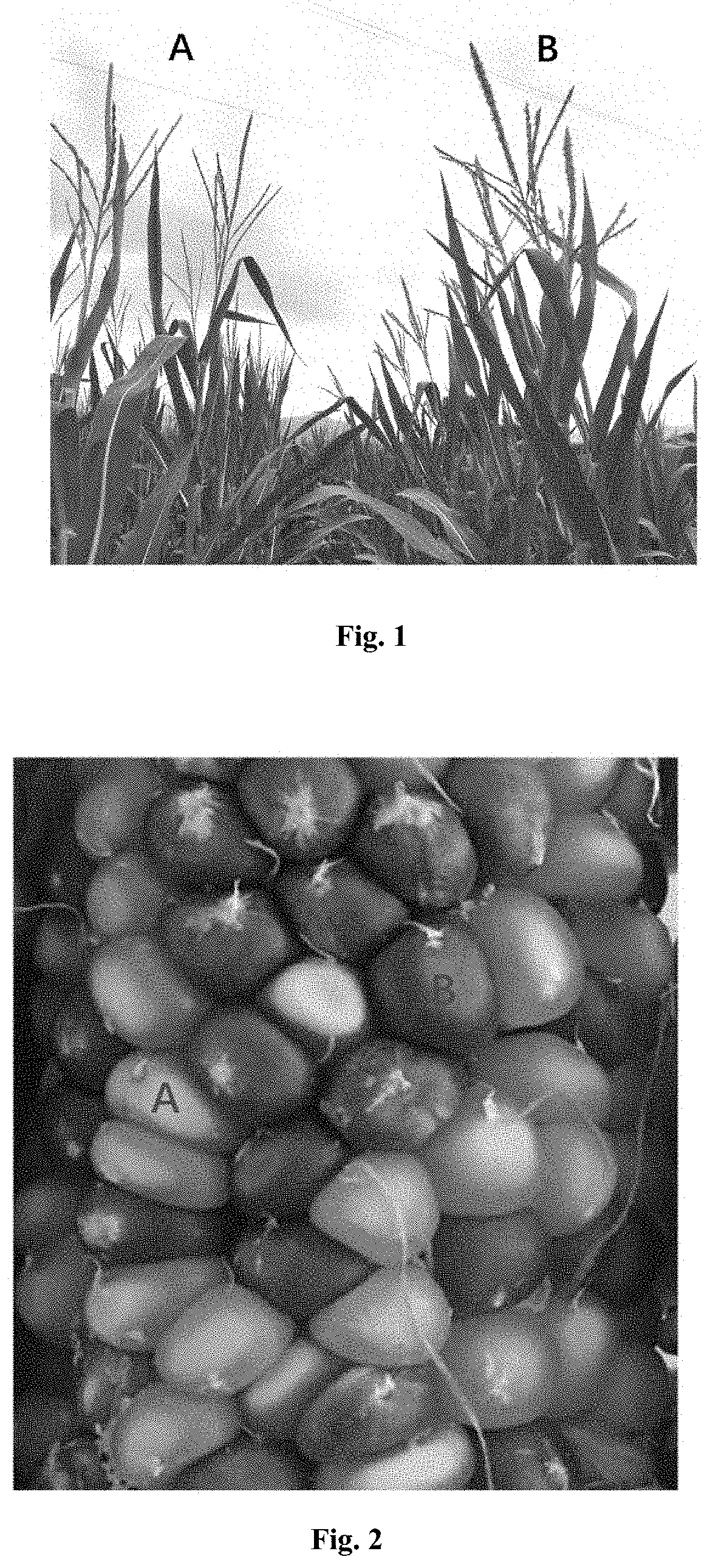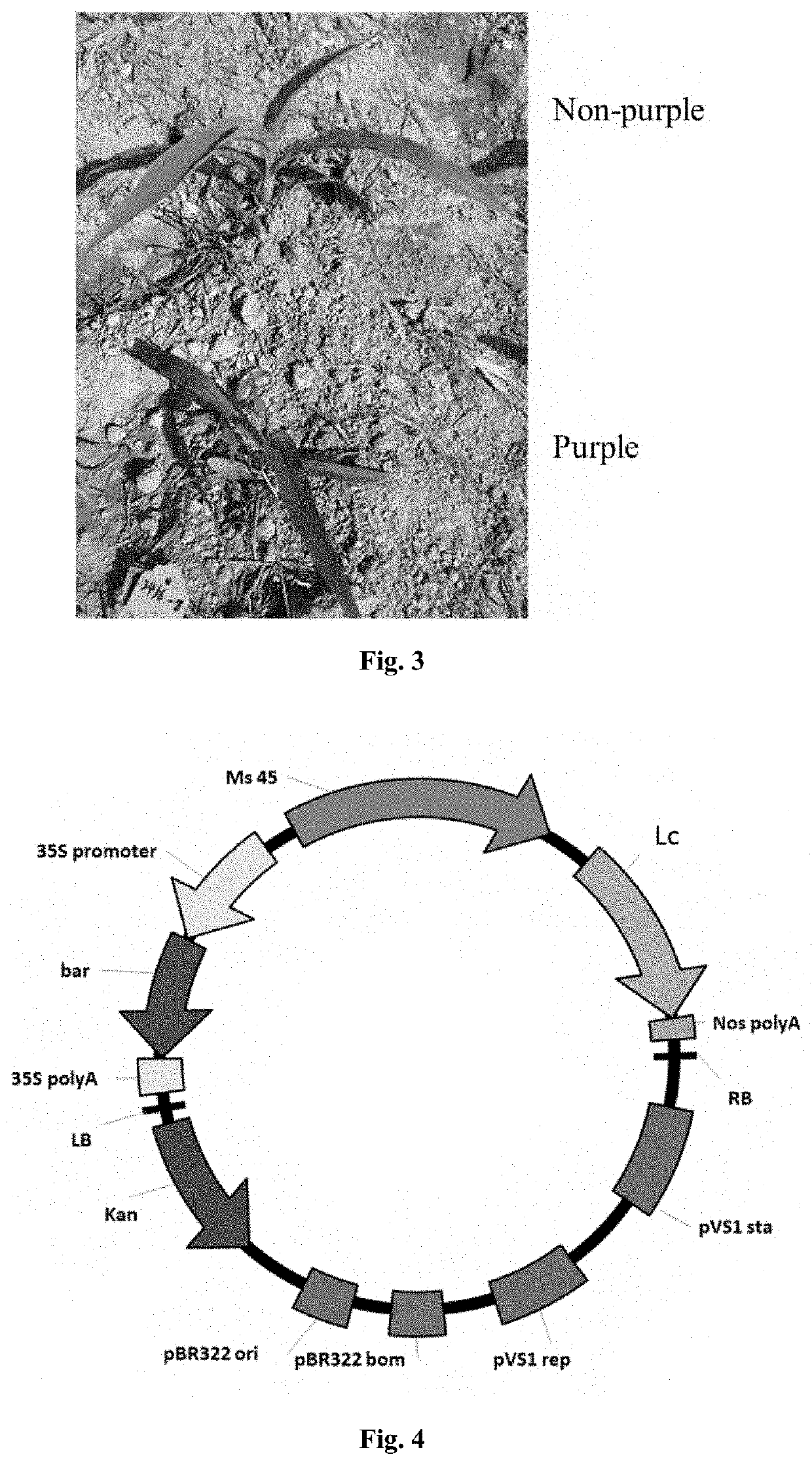Male sterility maintainer line plant and use thereof
a maintainer line plant and male sterility technology, applied in the field of plant genetic breeding and seed production, can solve the problems of incomplete emasculation, plant tassels, inability to self-pollination, etc., and achieve the effect of expanding the propagation of male sterility line plants, and effectively distinguishing
- Summary
- Abstract
- Description
- Claims
- Application Information
AI Technical Summary
Benefits of technology
Problems solved by technology
Method used
Image
Examples
example 2
ON OF TRANSGENIC MAIZE
[0213]The maize varieties HiIIA and HiIIB (Armstrong C L, Green C E and Phillips R L. Development and availability of germplasm with high Type II culture formation response. Maize Genetics Cooperation News Letter, 1991, 65:92-93) were planted in the field. They are separately bagged, pollinated, and hybridized when dispersing pollen. Two hybridization methods were used: HiIIA as the female parent and HiIIB as the male parent; or, HiIIA as the male parent and HiIIB as the female parent. 9 to 11 days after the pollination, the immature hybrid embryos were taken from the pollinated ear kernels, and the obtained recombinant Agrobacterium strains EHA105 / pMs45-Lc, EHA105 / pMs45-Lc and EHA105 / pMs45-Wi2 were used to infect the maize immature embryos respectively. The infected immature embryos were placed on a selection medium for multiple screenings to obtain resistant calli, and the resistant calli were regenerated into seedlings to obtain transgenic T0 generation plan...
example 3
LE EXPANSION OF MALE STERILITY LINES USING MALE STERILE MAINTAINER LINES
1. Preparation of Male Sterility Lines
[0241]The ms45 homozygous recessive mutant (Maize Genetics Cooperation Stock Center, 9051) was used as female parent and crossed with Zheng58 (Food Crops Research Institute, Henan Academy of Agricultural Sciences), and the obtained F1 continued to be backcrossed with the maize inbred line Zheng58. Genotype analysis was performed on the obtained BC1 (backcross generation) population, and the plants that were heterozygous at the Ms45 locus were screened and continued to be backcrossed with Zheng58. After 5 to 6 generations of such backcrossing, the individual plants with heterozygous Ms45 locus and agronomic traits similar to Zheng58 were screened by molecular markers and selfed to obtain ms45 homozygous recessive inbred line Zheng58 (ms45ms45), and the inbred line could be used as a male sterility line plant.
[0242]The method for screening the Ms45 locus genotype was as follow...
example 4
LE PRODUCTION OF HYBRIDS USING MALE STERILITY LINES
[0253]The sterile lines produced in Example 3 were recessive homozygous sterile lines controlled by nucleus, and the sterile lines could be restored to fertility by any wild-type plant (Ms45Ms45). Therefore, as long as an inbred line (for example, Chang 7-2) with high combining ability with the male sterility lines (for example, Zheng58) was selected, hybrids with excellent agronomic traits would be produced.
[0254]In order to achieve the above objects, Zheng58 and Chang 7-2 were subjected to alternate-row-seeding in the field, and no other maize was sown within 300 meters around the breeding field. Thus, the ears of the sterile lines could only accept the pollens of the wild-type inbred line, while the wild-type inbred line could only be selfed. In this way, the seeds produced on the ears of the sterile lines were dominant hybrids.
PUM
| Property | Measurement | Unit |
|---|---|---|
| temperature | aaaaa | aaaaa |
| concentration | aaaaa | aaaaa |
| color | aaaaa | aaaaa |
Abstract
Description
Claims
Application Information
 Login to View More
Login to View More - R&D
- Intellectual Property
- Life Sciences
- Materials
- Tech Scout
- Unparalleled Data Quality
- Higher Quality Content
- 60% Fewer Hallucinations
Browse by: Latest US Patents, China's latest patents, Technical Efficacy Thesaurus, Application Domain, Technology Topic, Popular Technical Reports.
© 2025 PatSnap. All rights reserved.Legal|Privacy policy|Modern Slavery Act Transparency Statement|Sitemap|About US| Contact US: help@patsnap.com



